Urban Human-Land Spatial Mismatch Analysis from a Source-Sink Perspective with ICT Support
Abstract
:1. Introduction
2. Materials and Methods
2.1. Study Area and Data Source
2.2. Research Method
2.2.1. Source-Sink of Urban Population
2.2.2. Urban Land Use Intensity
2.2.3. Bivariate Global Moran’s I and Bivariate LISA
2.2.4. Correspondence Analysis and Multiple Correspondence Analysis
3. Results and Analysis
3.1. Temporal and Spatial Patterns of Population Source-Sink
3.2. Spatial Correlation Analysis of Urban Population Source-Sink and Land Use Intensity
3.3. Spatial Mismatch in Urban Circle Structure and Land Use Function
3.3.1. Differential Influence of Spatial Mismatch in Different Urban Ring Road Areas
3.3.2. Differential Impact of Spatial Mismatch between Different Urban Land Use Types
3.4. Urban Human-Land Spatial Mismatch from a Dynamic Perspective
4. Discussion
4.1. Regularity of Population Source-Sink and Spatial Mismatch Characteristics
4.2. Policy Implications of Possible Spatial Mismatch Caused by Urban Sprawl
4.3. Limitations and Prospects
5. Conclusions
Author Contributions
Funding
Data Availability Statement
Acknowledgments
Conflicts of Interest
References
- Yu, A.T.W.; Wu, Y.; Zheng, B.; Zhang, X.; Shen, L. Identifying Risk Factors of Urban-Rural Conflict in Urbanization: A Case of China. Habitat Int. 2014, 44, 177–185. [Google Scholar] [CrossRef]
- Jiang, S.; Meng, J.; Zhu, L.; Cheng, H. Spatial-Temporal Pattern of Land Use Conflict in China and Its Multilevel Driving Mechanisms. Sci. Total Environ. 2021, 801, 149697. [Google Scholar] [CrossRef] [PubMed]
- Chen, D.; Lu, X.; Hu, W.; Zhang, C.; Lin, Y. How Urban Sprawl Influences Eco-Environmental Quality: Empirical Research in China by Using the Spatial Durbin Model. Ecol. Indic. 2021, 131, 108113. [Google Scholar] [CrossRef]
- Zhao, Z.-Q.; He, B.-J.; Li, L.-G.; Wang, H.-B.; Darko, A. Profile and Concentric Zonal Analysis of Relationships between Land Use/Land Cover and Land Surface Temperature: Case Study of Shenyang, China. Energy Build. 2017, 155, 282–295. [Google Scholar] [CrossRef]
- Fan, Y.; Fang, C. Eco-City and Man-Land Relationship. Acta Ecol. Sin. 2022, 42, 4313–4323. [Google Scholar] [CrossRef]
- Neuman, M. The Compact City Fallacy. J. Plan. Educ. Res. 2005, 25, 11–26. [Google Scholar] [CrossRef]
- Bibri, S.E. Compact Urbanism and the Synergic Potential of Its Integration with Data-Driven Smart Urbanism: An Extensive Interdisciplinary Literature Review. Land Use Policy 2020, 97, 104703. [Google Scholar] [CrossRef]
- Downs, A. What Does Smart Growth Really Mean? Planning 2001, 67, 20–25. [Google Scholar]
- Gabriel, S.A.; Faria, J.A.; Moglen, G.E. A Multiobjective Optimization Approach to Smart Growth in Land Development. Socio-Econ. Plan. Sci. 2006, 40, 212–248. [Google Scholar] [CrossRef] [Green Version]
- Feng, X.; Xiu, C.; Bai, L.; Zhong, Y.; Wei, Y. Comprehensive Evaluation of Urban Resilience Based on the Perspective of Landscape Pattern: A Case Study of Shenyang City. Cities 2020, 104, 102722. [Google Scholar] [CrossRef]
- Blasi, S.; Ganzaroli, A.; De Noni, I. Smartening Sustainable Development in Cities: Strengthening the Theoretical Linkage between Smart Cities and SDGs. Sustain. Cities Soc. 2022, 80, 103793. [Google Scholar] [CrossRef]
- Liu, Y.; Li, J.; Yang, Y. Strategic Adjustment of Land Use Policy under the Economic Transformation. Land Use Policy 2018, 74, 5–14. [Google Scholar] [CrossRef]
- Kuang, W.; Chi, W.; Lu, D.; Dou, Y. A Comparative Analysis of Megacity Expansions in China and the U.S.: Patterns, Rates and Driving Forces. Landsc. Urban Plan. 2014, 132, 121–135. [Google Scholar] [CrossRef]
- Wang, X.; Jiao, L.; Dong, T. A Comparative Analysis of Urban Sprawl Characteristics of High-Density and Low-Density Cities Comparative Analysis of Large Cities in China and America. Econ. Geogr. 2020, 40, 70–78. [Google Scholar] [CrossRef]
- Chen, Z.; Yu, B.; Hu, Y.; Huang, C.; Shi, K.; Wu, J. Estimating House Vacancy Rate in Metropolitan Areas Using NPP-VIIRS Nighttime Light Composite Data. IEEE J. Sel. Top. Appl. Earth Obs. Remote Sens. 2015, 8, 2188–2197. [Google Scholar] [CrossRef]
- Zheng, Q.; Deng, J.; Jiang, R.; Wang, K.; Xue, X.; Lin, Y.; Huang, Z.; Shen, Z.; Li, J.; Shahtahmassebi, A.R. Monitoring and Assessing “Ghost Cities” in Northeast China from the View of Nighttime Light Remote Sensing Data. Habitat Int. 2017, 70, 34–42. [Google Scholar] [CrossRef]
- Kain, J.F. Housing Segregation, Negro Employment, and Metropolitan Decentralization. Q. J. Econ. 1968, 82, 175–197. [Google Scholar] [CrossRef]
- Kain, J.F. A Pioneer’s Perspective on the Spatial Mismatch Literature. Urban Stud. 2004, 41, 7–32. [Google Scholar] [CrossRef]
- Ta, N.; Chai, Y.; Zhang, Y.; Sun, D. Understanding Job-Housing Relationship and Commuting Pattern in Chinese Cities: Past, Present and Future. Transp. Res. Part D Transp. Environ. 2017, 52, 562–573. [Google Scholar] [CrossRef]
- Zhao, P.; Lü, B.; de Roo, G. Impact of the Jobs-Housing Balance on Urban Commuting in Beijing in the Transformation Era. J. Transp. Geogr. 2011, 19, 59–69. [Google Scholar] [CrossRef]
- Liu, C.; Cao, M.; Yang, T.; Ma, L.; Wu, M.; Cheng, L.; Ye, R. Inequalities in the Commuting Burden: Institutional Constraints and Job-Housing Relationships in Tianjin, China. Res. Transp. Bus. Manag. 2022, 42, 100545. [Google Scholar] [CrossRef]
- Wang, F.; Luo, W. Assessing Spatial and Nonspatial Factors for Healthcare Access: Towards an Integrated Approach to Defining Health Professional Shortage Areas. Health Place 2005, 11, 131–146. [Google Scholar] [CrossRef] [PubMed]
- Wang, S.; Wang, M.; Liu, Y. Access to Urban Parks: Comparing Spatial Accessibility Measures Using Three GIS-Based Approaches. Comput. Environ. Urban Syst. 2021, 90, 101713. [Google Scholar] [CrossRef]
- Peng, Y.; Liu, J.; Zhang, T.; Li, X. The Relationship between Urban Population Density Distribution and Land Use in Guangzhou, China: A Spatial Spillover Perspective. Int. J. Environ. Res. Public Health 2021, 18, 12160. [Google Scholar] [CrossRef] [PubMed]
- Cote, M.; Nightingale, A.J. Resilience Thinking Meets Social Theory: Situating Social Change in Socio-Ecological Systems (SES) Research. Prog. Hum. Geogr. 2012, 36, 475–489. [Google Scholar] [CrossRef]
- Zhao, Z.; Bai, Y.; Wang, G.; Chen, J.; Yu, J.; Liu, W. Land Eco-Efficiency for New-Type Urbanization in the Beijing-Tianjin-Hebei Region. Technol. Forecast. Soc. Chang. 2018, 137, 19–26. [Google Scholar] [CrossRef]
- Botticini, F.; Auzins, A.; Lacoere, P.; Lewis, O.; Tiboni, M. Land Take and Value Capture: Towards More Efficient Land Use. Sustainability 2022, 14, 778. [Google Scholar] [CrossRef]
- Stewart, T.J.; Janssen, R.; van Herwijnen, M. A Genetic Algorithm Approach to Multiobjective Land Use Planning. Comput. Oper. Res. 2004, 31, 2293–2313. [Google Scholar] [CrossRef]
- Li, X.; Liu, X. Embedding Sustainable Development Strategies in Agent-based Models for Use as a Planning Tool. Int. J. Geogr. Inf. Sci. 2008, 22, 21–45. [Google Scholar] [CrossRef]
- Liu, S.; Xiao, W.; Li, L.; Ye, Y.; Song, X. Urban Land Use Efficiency and Improvement Potential in China: A Stochastic Frontier Analysis. Land Use Policy 2020, 99, 105046. [Google Scholar] [CrossRef]
- Peng, C.; Li, B.; Nan, B. An Analysis Framework for the Ecological Security of Urban Agglomeration: A Case Study of the Beijing-Tianjin-Hebei Urban Agglomeration. J. Clean. Prod. 2021, 315, 128111. [Google Scholar] [CrossRef]
- Das, B.; Singh, A.; Panda, S.N.; Yasuda, H. Optimal Land and Water Resources Allocation Policies for Sustainable Irrigated Agriculture. Land Use Policy 2015, 42, 527–537. [Google Scholar] [CrossRef]
- Chang, Y.-C.; Ko, T.-T. An Interactive Dynamic Multi-Objective Programming Model to Support Better Land Use Planning. Land Use Policy 2014, 36, 13–22. [Google Scholar] [CrossRef] [Green Version]
- Wu, W.; Luo, X.; Knopp, J.; Jones, L.; Banzhaf, E. A European-Chinese Exploration: Part 2—Urban Ecosystem Service Patterns, Processes, and Contributions to Environmental Equity under Different Scenarios. Remote Sens. 2022, 14, 3488. [Google Scholar] [CrossRef]
- Xu, L.; Liu, X.; Tong, D.; Liu, Z.; Yin, L.; Zheng, W. Forecasting Urban Land Use Change Based on Cellular Automata and the PLUS Model. Land 2022, 11, 652. [Google Scholar] [CrossRef]
- Yuan, M.; Liu, Y.; He, J.; Liu, D. Regional Land-Use Allocation Using a Coupled MAS and GA Model: From Local Simulation to Global Optimization, a Case Study in Caidian District, Wuhan, China. Cartogr. Geogr. Inf. Sci. 2014, 41, 363–378. [Google Scholar] [CrossRef]
- Cao, K.; Liu, M.; Wang, S.; Liu, M.; Zhang, W.; Meng, Q.; Huang, B. Spatial Multi-Objective Land Use Optimization toward Livability Based on Boundary-Based Genetic Algorithm: A Case Study in Singapore. ISPRS Int. J. Geo-Inf. 2020, 9, 40. [Google Scholar] [CrossRef] [Green Version]
- Seto, K.C.; Sánchez-Rodríguez, R.; Fragkias, M. The New Geography of Contemporary Urbanization and the Environment. Annu. Rev. Environ. Resour. 2010, 35, 167–194. [Google Scholar] [CrossRef] [Green Version]
- Easley, J. Spatial Mismatch beyond Black and White: Levels and Determinants of Job Access among Asian and Hispanic Subpopulations. Urban Stud. 2018, 55, 1800–1820. [Google Scholar] [CrossRef]
- Gao, S.; Janowicz, K.; Couclelis, H. Extracting Urban Functional Regions from Points of Interest and Human Activities on Location-Based Social Networks. Trans. GIS 2017, 21, 446–467. [Google Scholar] [CrossRef]
- Wang, S.; Xu, G.; Guo, Q. Street Centralities and Land Use Intensities Based on Points of Interest (POI) in Shenzhen, China. ISPRS Int. J. Geo-Inf. 2018, 7, 425. [Google Scholar] [CrossRef]
- Zhang, X.; Du, S.; Wang, Q. Hierarchical Semantic Cognition for Urban Functional Zones with VHR Satellite Images and POI Data. ISPRS J. Photogramm. Remote Sens. 2017, 132, 170–184. [Google Scholar] [CrossRef]
- Pan, G.; Qi, G.; Wu, Z.; Zhang, D.; Li, S. Land-Use Classification Using Taxi GPS Traces. IEEE Trans. Intell. Transp. Syst. 2013, 14, 113–123. [Google Scholar] [CrossRef]
- Wellmann, T.; Haase, D.; Knapp, S.; Salbach, C.; Selsam, P.; Lausch, A. Urban Land Use Intensity Assessment: The Potential of Spatio-Temporal Spectral Traits with Remote Sensing. Ecol. Indic. 2018, 85, 190–203. [Google Scholar] [CrossRef]
- Cheng, L.; Chen, C.; Xiu, C. Excess Kindergarten Travel in Changchun, Northeast China: A Measure of Residence-Kindergarten Spatial Mismatch. J. Transp. Geogr. 2017, 60, 208–216. [Google Scholar] [CrossRef]
- Shen, Y.; Sun, F.; Che, Y. Public Green Spaces and Human Wellbeing: Mapping the Spatial Inequity and Mismatching Status of Public Green Space in the Central City of Shanghai. Urban For. Urban Green. 2017, 27, 59–68. [Google Scholar] [CrossRef]
- Liu, Z.; Ma, T.; Du, Y.; Pei, T.; Yi, J.; Peng, H. Mapping Hourly Dynamics of Urban Population Using Trajectories Reconstructed from Mobile Phone Records. Trans. GIS 2018, 22, 494–513. [Google Scholar] [CrossRef]
- Liu, W.; Wu, W.; Thakuriah, P.; Wang, J. The Geography of Human Activity and Land Use: A Big Data Approach. Cities 2020, 97, 102523. [Google Scholar] [CrossRef]
- Chen, Y.; Liu, X.; Li, X. Analyzing Parcel-Level Relationships between Urban Land Expansion and Activity Changes by Integrating Landsat and Nighttime Light Data. Remote Sens. 2017, 9, 164. [Google Scholar] [CrossRef] [Green Version]
- Xia, C.; Yeh, A.G.-O.; Zhang, A. Analyzing Spatial Relationships between Urban Land Use Intensity and Urban Vitality at Street Block Level: A Case Study of Five Chinese Megacities. Landsc. Urban Plan. 2020, 193, 103669. [Google Scholar] [CrossRef]
- Xu, G.; Su, J.; Xia, C.; Li, X.; Xiao, R. Spatial Mismatches between Nighttime Light Intensity and Building Morphology in Shanghai, China. Sustain. Cities Soc. 2022, 81, 103851. [Google Scholar] [CrossRef]
- Li, J.; Li, J.; Yuan, Y.; Li, G. Spatiotemporal Distribution Characteristics and Mechanism Analysis of Urban Population Density: A Case of Xi’an, Shaanxi, China. Cities 2019, 86, 62–70. [Google Scholar] [CrossRef]
- Calabrese, F.; Diao, M.; Di Lorenzo, G.; Ferreira, J.; Ratti, C. Understanding Individual Mobility Patterns from Urban Sensing Data: A Mobile Phone Trace Example. Transp. Res. Part C Emerg. Technol. 2013, 26, 301–313. [Google Scholar] [CrossRef]
- Dong, X.; Xu, Y.; Huang, L.; Liu, Z.; Xu, Y.; Zhang, K.; Hu, Z.; Wu, G. Exploring Impact of Spatial Unit on Urban Land Use Mapping with Multisource Data. Remote Sens. 2020, 12, 3597. [Google Scholar] [CrossRef]
- Liu, B.; Deng, Y.; Li, M.; Yang, J.; Liu, T. Classification Schemes and Identification Methods for Urban Functional Zone: A Review of Recent Papers. Appl. Sci. 2021, 11, 9968. [Google Scholar] [CrossRef]
- Pulliam, H.R. Sources, Sinks, and Population Regulation. Am. Nat. 1988, 132, 652–661. [Google Scholar] [CrossRef]
- Li, W.; Cao, Q.; Lang, K.; Wu, J. Linking Potential Heat Source and Sink to Urban Heat Island: Heterogeneous Effects of Landscape Pattern on Land Surface Temperature. Sci. Total Environ. 2017, 586, 457–465. [Google Scholar] [CrossRef] [PubMed]
- Sun, R.; Xie, W.; Chen, L. A Landscape Connectivity Model to Quantify Contributions of Heat Sources and Sinks in Urban Regions. Landsc. Urban Plan. 2018, 178, 43–50. [Google Scholar] [CrossRef]
- Chen, L.; Sun, R.; Lu, Y. A Conceptual Model for a Process-Oriented Landscape Pattern Analysis. Sci. China Earth Sci. 2019, 62, 2050–2057. [Google Scholar] [CrossRef]
- Liu, Y.; Wang, F.; Xiao, Y.; Gao, S. Urban Land Uses and Traffic ‘Source-Sink Areas’: Evidence from GPS-Enabled Taxi Data in Shanghai. Landsc. Urban Plan. 2012, 106, 73–87. [Google Scholar] [CrossRef]
- Wang, Y.; Wang, F.; Zhang, Y.; Liu, Y. Delineating Urbanization “Source-Sink” Regions in China: Evidence from Mobile App Data. Cities 2019, 86, 167–177. [Google Scholar] [CrossRef]
- Erb, K.-H. How a Socio-Ecological Metabolism Approach Can Help to Advance Our Understanding of Changes in Land-Use Intensity. Ecol. Econ. 2012, 76, 8–14. [Google Scholar] [CrossRef] [PubMed] [Green Version]
- Zeng, C.; Yang, L.; Dong, J. Management of Urban Land Expansion in China through Intensity Assessment: A Big Data Perspective. J. Clean. Prod. 2017, 153, 637–647. [Google Scholar] [CrossRef]
- Erb, K.-H.; Haberl, H.; Jepsen, M.R.; Kuemmerle, T.; Lindner, M.; Müller, D.; Verburg, P.H.; Reenberg, A. A Conceptual Framework for Analysing and Measuring Land-Use Intensity. Curr. Opin. Environ. Sustain. 2013, 5, 464–470. [Google Scholar] [CrossRef] [Green Version]
- Chen, Y.; Chen, Z.; Xu, G.; Tian, Z. Built-up Land Efficiency in Urban China: Insights from the General Land Use Plan (2006–2020). Habitat Int. 2016, 51, 31–38. [Google Scholar] [CrossRef]
- Ye, Y.; Li, D.; Liu, X. How Block Density and Typology Affect Urban Vitality: An Exploratory Analysis in Shenzhen, China. Urban Geogr. 2018, 39, 631–652. [Google Scholar] [CrossRef]
- Zhang, P.; Yang, D.; Qin, M.; Jing, W. Spatial Heterogeneity Analysis and Driving Forces Exploring of Built-up Land Development Intensity in Chinese Prefecture-Level Cities and Implications for Future Urban Land Intensive Use. Land Use Policy 2020, 99, 104958. [Google Scholar] [CrossRef]
- Zhong, T.; Qian, Z.; Huang, X.; Zhao, Y.; Zhou, Y.; Zhao, Z. Impact of the Top-down Quota-Oriented Farmland Preservation Planning on the Change of Urban Land-Use Intensity in China. Habitat Int. 2018, 77, 71–79. [Google Scholar] [CrossRef]
- Wang, L.; Zhang, S.; Tang, L.; Lu, Y.; Liu, Y.; Liu, Y. Optimizing Distribution of Urban Land on the Basis of Urban Land Use Intensity at Prefectural City Scale in Mainland China. Land Use Policy 2022, 115, 106037. [Google Scholar] [CrossRef]
- Sun, Y.; Zhao, S.; Qu, W. Quantifying Spatiotemporal Patterns of Urban Expansion in Three Capital Cities in Northeast China over the Past Three Decades Using Satellite Data Sets. Environ. Earth Sci. 2015, 73, 7221–7235. [Google Scholar] [CrossRef]
- Li, Z.; Luan, W.; Zhang, Z.; Su, M. Relationship between Urban Construction Land Expansion and Population/Economic Growth in Liaoning Province, China. Land Use Policy 2020, 99, 105022. [Google Scholar] [CrossRef]
- Zhao, Z.; Sharifi, A.; Dong, X.; Shen, L.; He, B.-J. Spatial Variability and Temporal Heterogeneity of Surface Urban Heat Island Patterns and the Suitability of Local Climate Zones for Land Surface Temperature Characterization. Remote Sens. 2021, 13, 4338. [Google Scholar] [CrossRef]
- Gong, P.; Chen, B.; Li, X.; Liu, H.; Wang, J.; Bai, Y.; Chen, J.; Chen, X.; Fang, L.; Feng, S.; et al. Mapping Essential Urban Land Use Categories in China (EULUC-China): Preliminary Results for 2018. Sci. Bull. 2020, 65, 182–187. [Google Scholar] [CrossRef] [Green Version]
- Anselin, L. Local Indicators of Spatial Association—LISA. Geogr. Anal. 1995, 27, 93–115. [Google Scholar] [CrossRef]
- Wu, J.; He, H.; Hu, T. Analysis of Factors Influencing the “Source-Sink” Landscape Contribution of Land Surface Temperature. Dili Xuebao/Acta Geogr. Sin. 2022, 77, 51–65. [Google Scholar] [CrossRef]
- Di Franco, G. Multiple Correspondence Analysis: One Only or Several Techniques? Qual. Quant. 2016, 50, 1299–1315. [Google Scholar] [CrossRef]
- González, M.C.; Hidalgo, C.A.; Barabási, A.-L. Understanding Individual Human Mobility Patterns. Nature 2008, 453, 779–782. [Google Scholar] [CrossRef]
- Song, C.; Qu, Z.; Blumm, N.; Barabási, A.-L. Limits of Predictability in Human Mobility. Science 2010, 327, 1018–1021. [Google Scholar] [CrossRef] [Green Version]
- Lu, X.; Wetter, E.; Bharti, N.; Tatem, A.J.; Bengtsson, L. Approaching the Limit of Predictability in Human Mobility. Sci. Rep. 2013, 3, 2923. [Google Scholar] [CrossRef] [Green Version]
- Zhao, P.; Hu, H. Geographical Patterns of Traffic Congestion in Growing Megacities: Big Data Analytics from Beijing. Cities 2019, 92, 164–174. [Google Scholar] [CrossRef]
- Brum-Bastos, V.S.; Long, J.A.; Demšar, U. Weather Effects on Human Mobility: A Study Using Multi-Channel Sequence Analysis. Comput. Environ. Urban Syst. 2018, 71, 131–152. [Google Scholar] [CrossRef]
- Zhang, X.; Li, N. Characterizing Individual Mobility Perturbations in Cities during Extreme Weather Events. Int. J. Disaster Risk Reduct. 2022, 72, 102849. [Google Scholar] [CrossRef]
- Williams, S.; Xu, W.; Tan, S.B.; Foster, M.J.; Chen, C. Ghost Cities of China: Identifying Urban Vacancy through Social Media Data. Cities 2019, 94, 275–285. [Google Scholar] [CrossRef]
- Chen, M.; Liu, W.; Lu, D. Challenges and the Way Forward in China’s New-Type Urbanization. Land Use Policy 2016, 55, 334–339. [Google Scholar] [CrossRef]
- Li, G.; Li, F. Urban Sprawl in China: Differences and Socioeconomic Drivers. Sci. Total Environ. 2019, 673, 367–377. [Google Scholar] [CrossRef]
- Liu, Z.; Liu, S.; Qi, W.; Jin, H. Urban Sprawl among Chinese Cities of Different Population Sizes. Habitat Int. 2018, 79, 89–98. [Google Scholar] [CrossRef]
- Yu, H.; Yang, J.; Li, T.; Jin, Y.; Sun, D. Morphological and Functional Polycentric Structure Assessment of Megacity: An Integrated Approach with Spatial Distribution and Interaction. Sustain. Cities Soc. 2022, 80, 103800. [Google Scholar] [CrossRef]
- Lan, F.; Gong, X.; Da, H.; Wen, H. How Do Population Inflow and Social Infrastructure Affect Urban Vitality? Evidence from 35 Large- and Medium-Sized Cities in China. Cities 2020, 100, 102454. [Google Scholar] [CrossRef]
- Cai, Z.; Liu, Q.; Cao, S. Real Estate Supports Rapid Development of China’s Urbanization. Land Use Policy 2020, 95, 104582. [Google Scholar] [CrossRef]
- Zhou, D.; Li, Z.; Wang, S.; Tian, Y.; Zhang, Y.; Jiang, G. How Does the Newly Urban Residential Built-up Density Differ across Chinese Cities under Rapid Urban Expansion? Evidence from Residential FAR and Statistical Data from 2007 to 2016. Land Use Policy 2021, 104, 105365. [Google Scholar] [CrossRef]
- Brueckner, J.K. Urban Sprawl: Diagnosis and Remedies. Int. Reg. Sci. Rev. 2000, 23, 160–171. [Google Scholar] [CrossRef]
- Yue, W.; Zhang, L.; Liu, Y. Measuring Sprawl in Large Chinese Cities along the Yangtze River via Combined Single and Multidimensional Metrics. Habitat Int. 2016, 57, 43–52. [Google Scholar] [CrossRef]
- Sevtsuk, A.; Ratti, C. Does Urban Mobility Have a Daily Routine? Learning from the Aggregate Data of Mobile Networks. J. Urban Technol. 2010, 17, 41–60. [Google Scholar] [CrossRef]
- Monsivais, D.; Ghosh, A.; Bhattacharya, K.; Dunbar, R.I.M.; Kaski, K. Tracking Urban Human Activity from Mobile Phone Calling Patterns. PLOS Comput. Biol. 2017, 13, e1005824. [Google Scholar] [CrossRef] [PubMed]
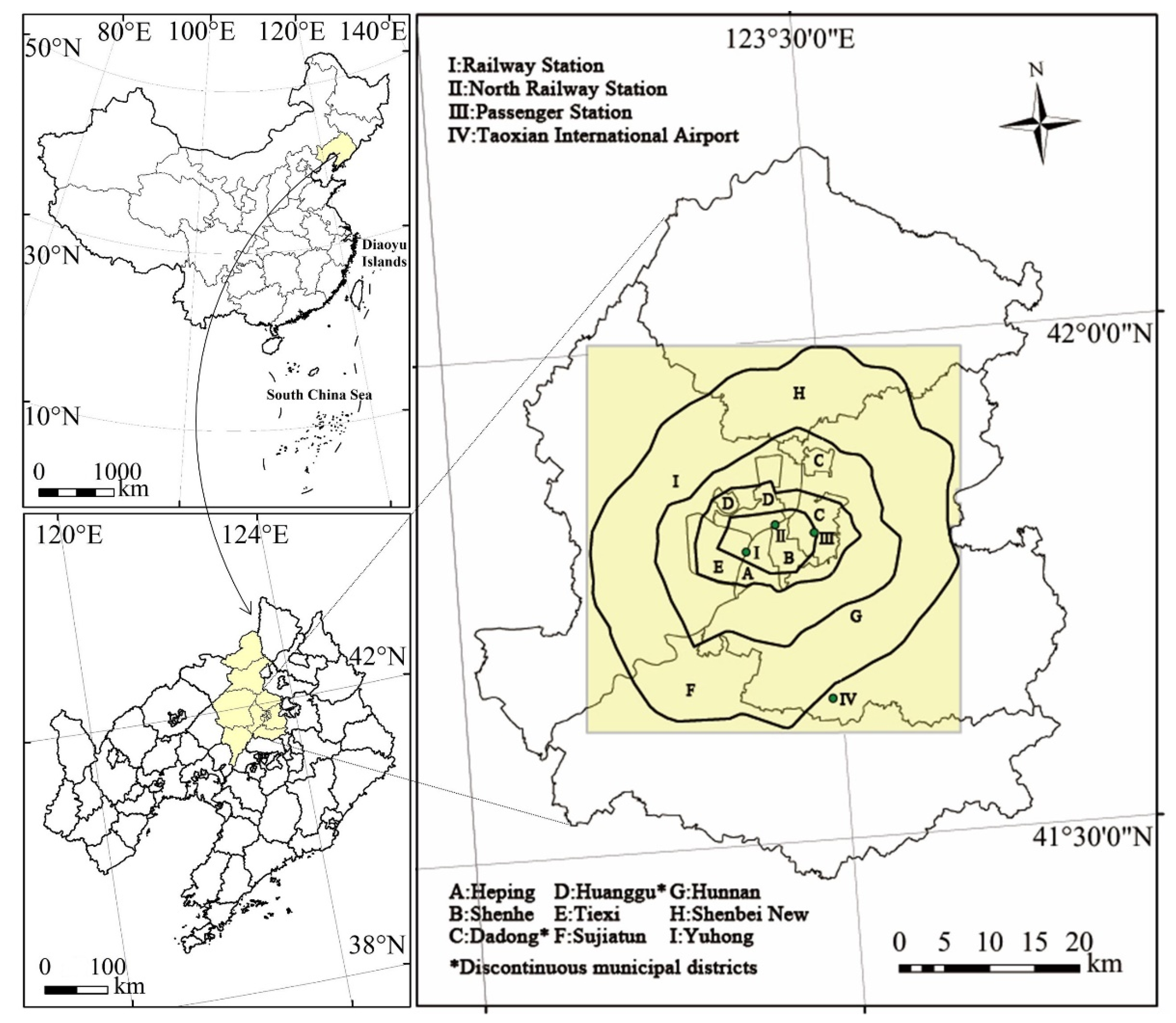

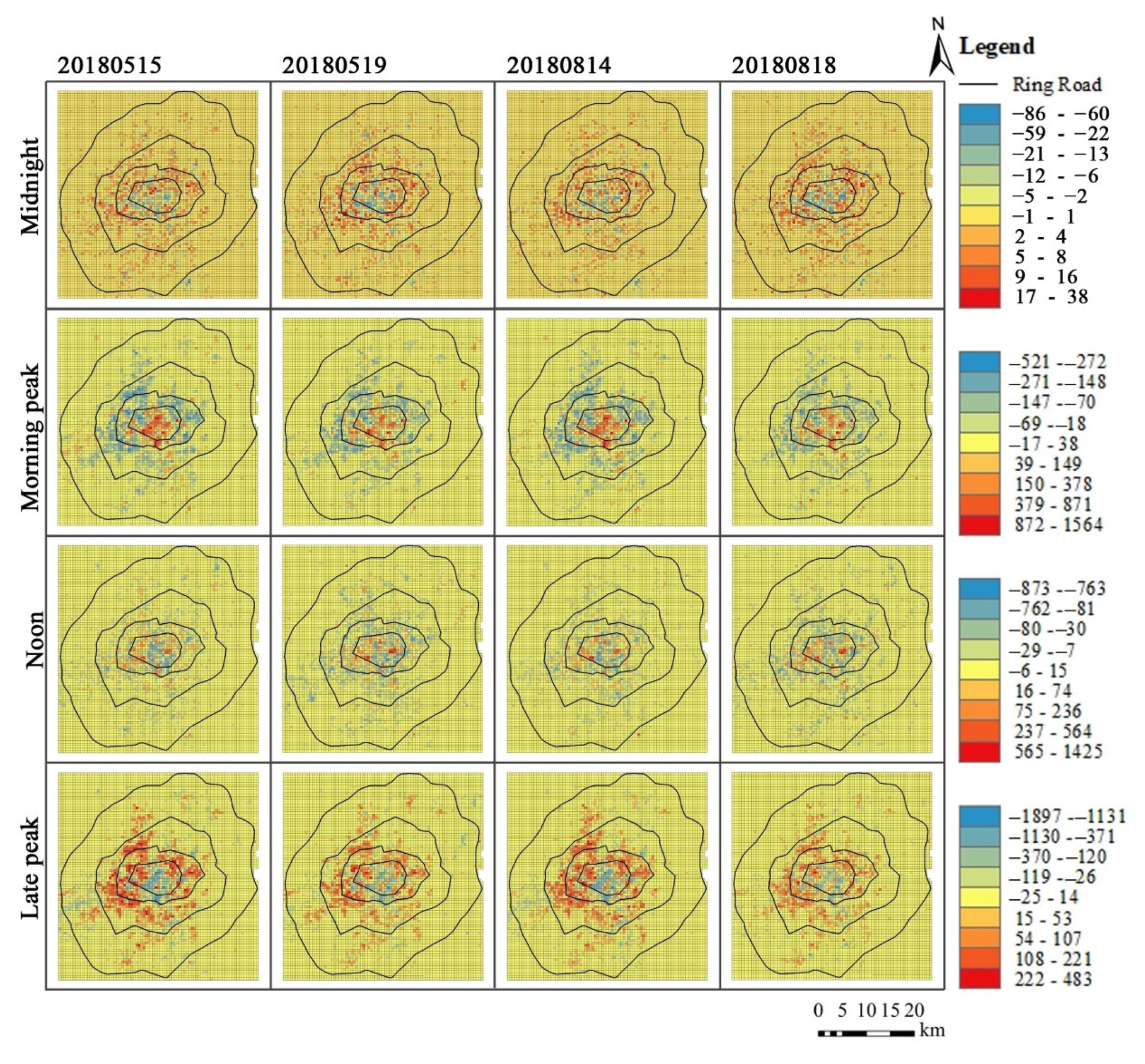
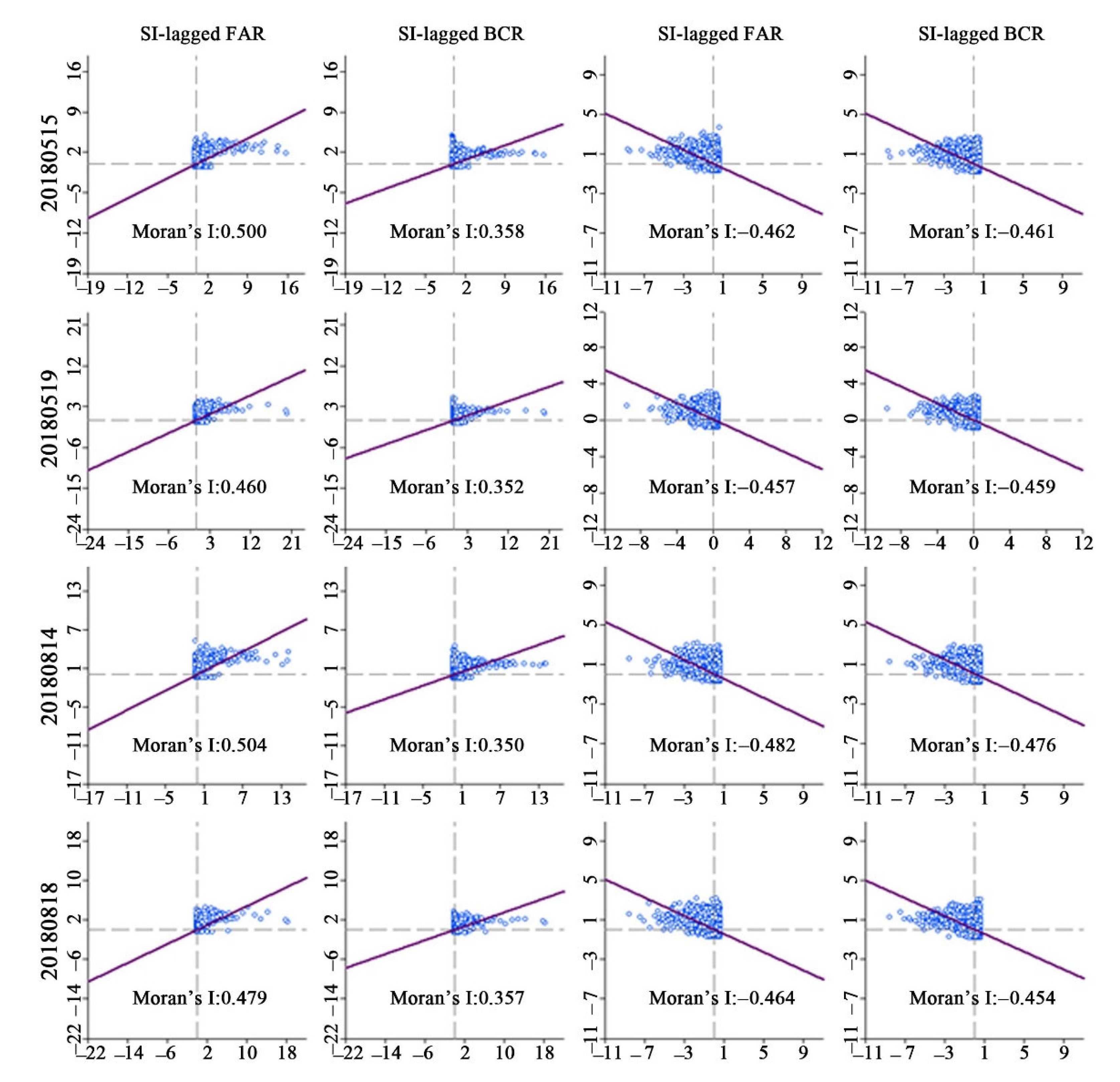
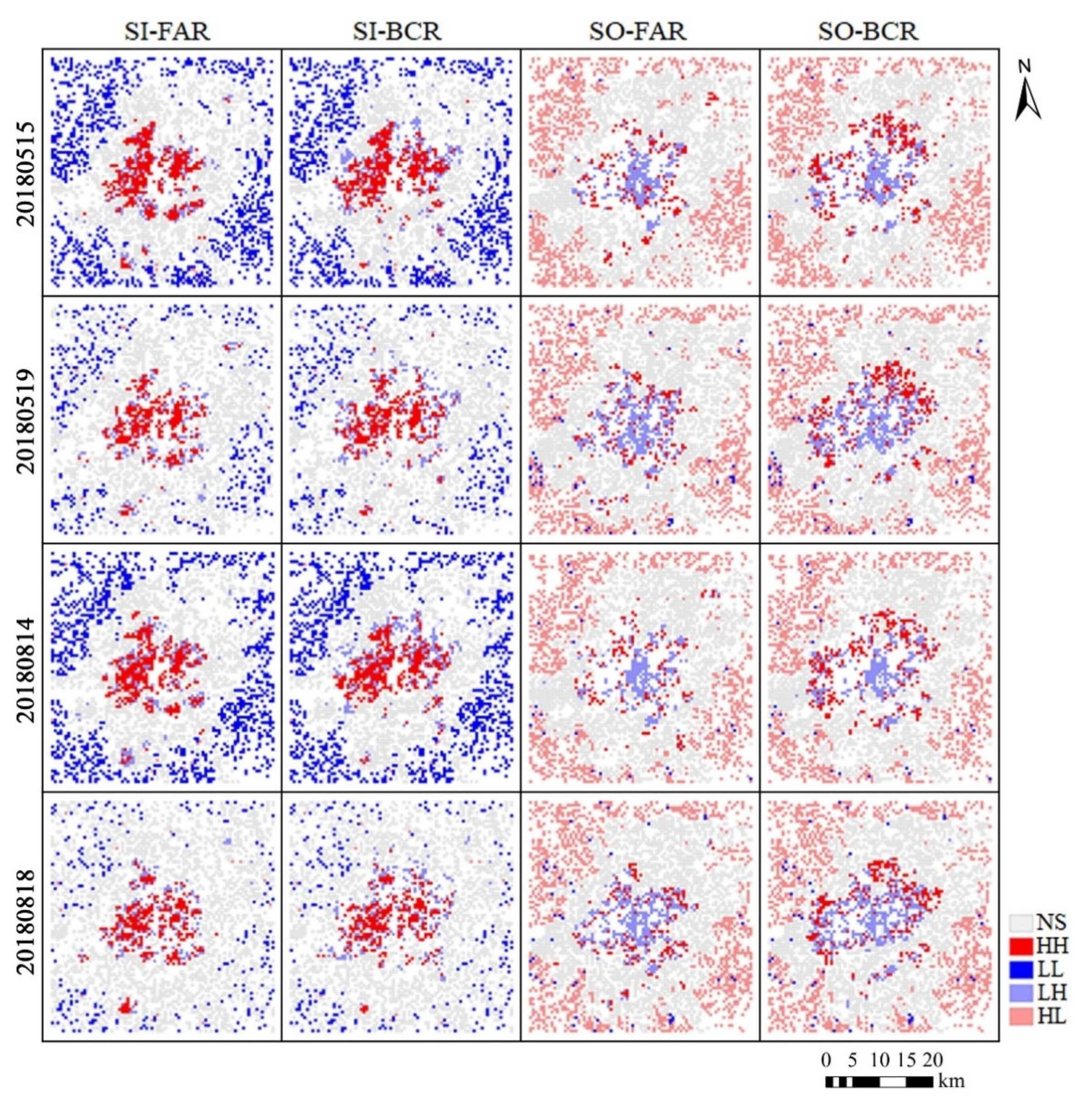

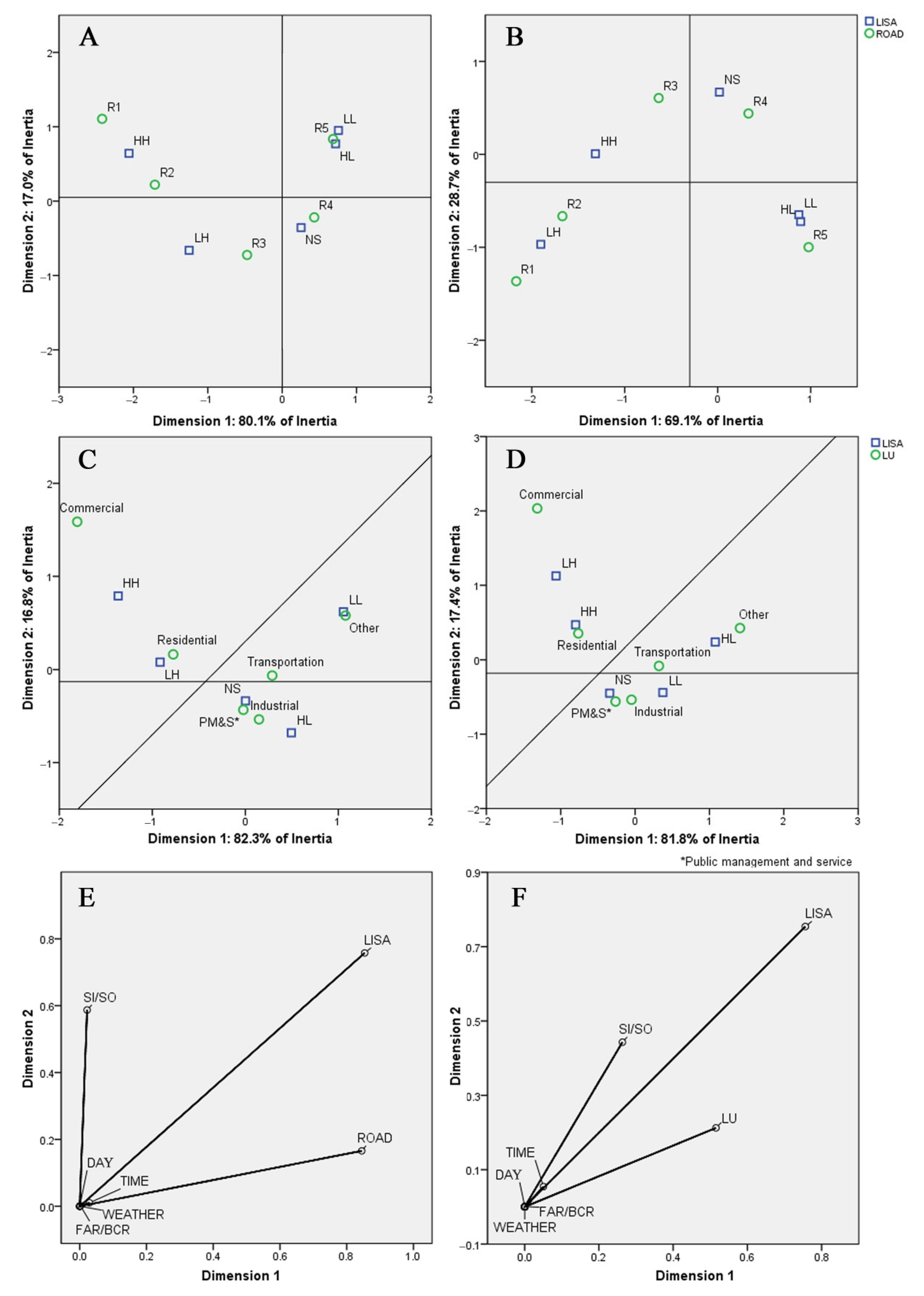
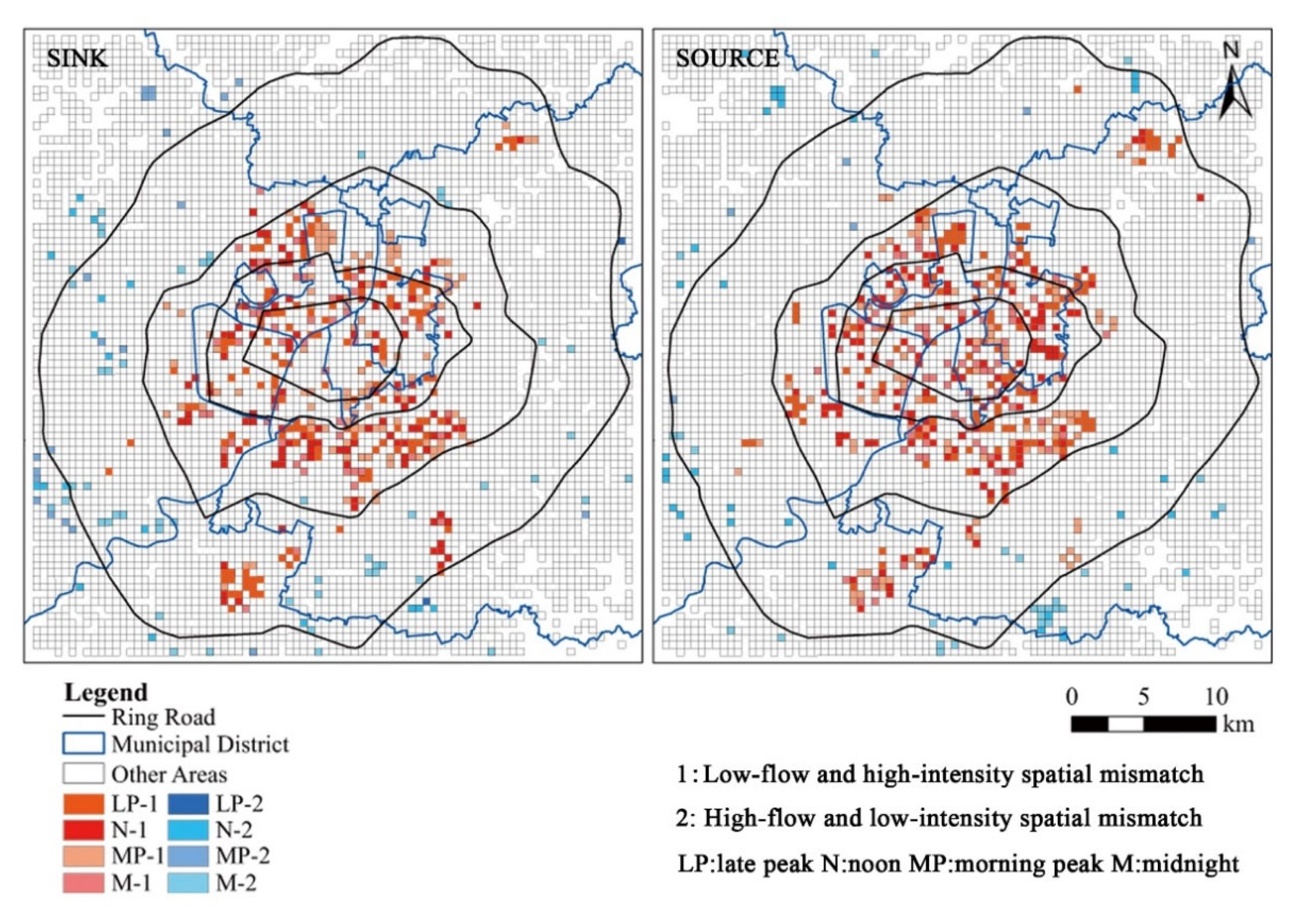
| Data Source and Description | Time | Spatial Resolution | Usage | |
|---|---|---|---|---|
| Mobile phone signaling data | China Unicom Smart Steps (http://www.smartsteps.com/) accessed on 13 December 2018 | 2018 | 500 m | Calculate population source-sink value |
| Building data/urban road data | AutoNavi map (https://www.amap.com/) accessed on 15 December 2020 | 2019 | vector data | Calculate FAR and BCR |
| Land use data | ELUC-China/FROM-GLC10 (http://data.ess.tsinghua.edu.cn/) accessed on 1 March 2020 | 2018 | 10 m | Land use types |
| Historical Weather Data | Envicloud (http://www.envicloud.cn/) accessed on 3 March 2021 | 2018 | hourly/daily | Weather |
| Date | Day | Weather | Rainfall (mm) | Temperature Average (°C) | Influence of Special Events |
|---|---|---|---|---|---|
| 20180515 | Tuesday | No rain | 0 | 20.55 | No |
| 20180519 | Saturday | No rain | 0 | 21.45 | No |
| 20180814 | Tuesday | Moderate rain | 17.80 | 24.01 | No |
| 20180818 | Saturday | Moderate rain | 10.20 | 21.85 | No |
| Variables | Assignment |
|---|---|
| LISA | 1 = HH, 2 = LL, 3 = LH, 4 = HL, 5 = NS |
| SI/SO | 1 = Sink, 2 = Source |
| FAR/BCR | 1 = FAR, 2 = BCR |
| Road 1 | 1 = R1, 2 = R2, 3 = R3, 4 = R4, 5 = R5 |
| LU (Land use type) | 1 = Residential, 2 = Commercial, 3 = Industrial, 4 = Transportation, 5 = Public management and service, 6 = Other |
| Weather | 1 = No rain, 2 = Rain |
| Day | 1 = Weekday, 2 = Weekend |
| Time | 1 = Midnight, 2 = Morning Peak, 3 = Noon, 4 = Late Peak |
| Types | Midnight | Morning Peak | Noon | Late Peak | 24 h | ||||||
|---|---|---|---|---|---|---|---|---|---|---|---|
| FAR | BCR | FAR | BCR | FAR | BCR | FAR | BCR | FAR | BCR | ||
| 2018 0515 | Sink | 0.375 | 0.364 | 0.500 | 0.358 | 0.390 | 0.308 | 0.486 | 0.469 | 0.414 | 0.358 |
| Source | −0.344 | −0.274 | −0.462 | −0.461 | −0.345 | −0.276 | −0.463 | −0.322 | −0.352 | −0.254 | |
| 2018 0519 | Sink | 0.391 | 0.377 | 0.460 | 0.352 | 0.292 | 0.229 | 0.456 | 0.446 | 0.323 | 0.277 |
| Source | −0.425 | −0.335 | −0.457 | −0.459 | −0.351 | −0.316 | −0.395 | −0.296 | −0.268 | −0.220 | |
| 2018 0814 | Sink | 0.338 | 0.346 | 0.504 | 0.350 | 0.328 | 0.256 | 0.503 | 0.469 | 0.327 | 0.271 |
| Source | −0.320 | −0.265 | −0.482 | −0.476 | −0.336 | −0.286 | −0.467 | −0.334 | −0.372 | −0.267 | |
| 2018 0818 | Sink | 0.378 | 0.387 | 0.479 | 0.357 | 0.315 | 0.237 | 0.468 | 0.461 | 0.316 | 0.259 |
| Source | −0.402 | −0.310 | −0.464 | −0.454 | −0.381 | −0.330 | −0.400 | −0.293 | −0.251 | −0.221 | |
Publisher’s Note: MDPI stays neutral with regard to jurisdictional claims in published maps and institutional affiliations. |
© 2022 by the authors. Licensee MDPI, Basel, Switzerland. This article is an open access article distributed under the terms and conditions of the Creative Commons Attribution (CC BY) license (https://creativecommons.org/licenses/by/4.0/).
Share and Cite
Li, T.; Xiu, C.; Yu, H. Urban Human-Land Spatial Mismatch Analysis from a Source-Sink Perspective with ICT Support. ISPRS Int. J. Geo-Inf. 2022, 11, 575. https://doi.org/10.3390/ijgi11110575
Li T, Xiu C, Yu H. Urban Human-Land Spatial Mismatch Analysis from a Source-Sink Perspective with ICT Support. ISPRS International Journal of Geo-Information. 2022; 11(11):575. https://doi.org/10.3390/ijgi11110575
Chicago/Turabian StyleLi, Tong, Chunliang Xiu, and Huisheng Yu. 2022. "Urban Human-Land Spatial Mismatch Analysis from a Source-Sink Perspective with ICT Support" ISPRS International Journal of Geo-Information 11, no. 11: 575. https://doi.org/10.3390/ijgi11110575









